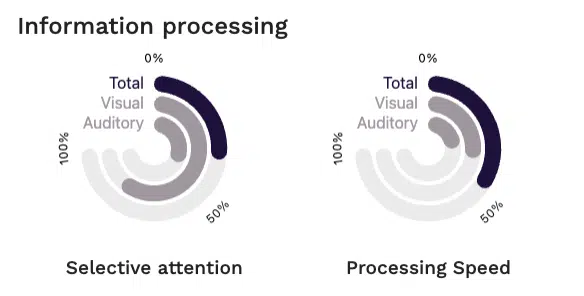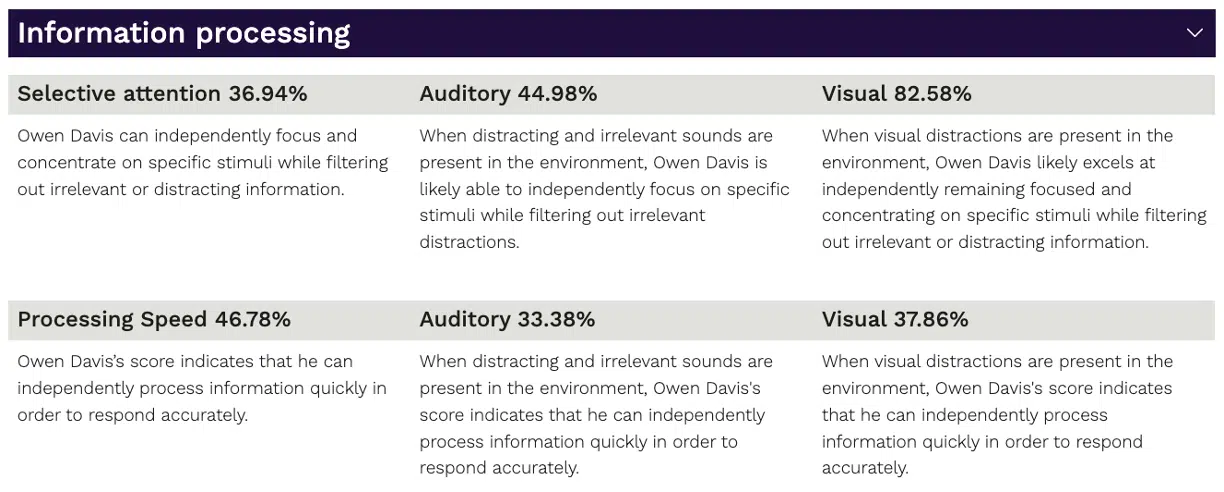This article explores how MOXO Profiler can elevate learners’ academic success by providing actionable information on their selective attention.
Executive functions are critical for academic success (Cortés Pascual et al., 2019). One such executive function is selective attention (Ahmad & Sultana, 2021),which allows learners to focus on pertinent information and tasks while filtering out irrelevant and distracting information. In the complex and often stimulus-rich environment of the classroom, the ability to hone in on important instructions, concentrate on exam questions, or persist in solving a challenging problem without being sidetracked is essential for learning and academic success.
Selective attention facilitates deeper cognitive processing of educational content, enabling students to absorb and retain information more effectively, therefore facilitating learning (Jiang & Chun, 2001). Moreover, selective attention aids in the development of other cognitive skills necessary for academic achievement. For instance, it supports working memory by helping students maintain focus on task-relevant information (Sreenivasan & Jha, 2007), thus enhancing their ability to manipulate and apply this information in various academic contexts.

In the academic setting a broad body of literature explores the neurobiological basis for selective attention in education. Findings highlight the important role of selective attention on language processing, literacy and mathematics (Stevens & Bavelier, 2012). Findings also highlight the malleability of the skill, suggesting that with proper intervention and training both children and adults can improve their selective attention abilities (Stevens & Bavelier, 2012).

aken together, selective attention is integral to academic performance. Providing educators with accurate assessments of a learner’s selective attention is pivotal in enhancing educational outcomes. The MOXO Profiler not only offers precise insights into a learner’s ability to selectively attend to stimuli in general, it also provides data about selective attention amid auditory and visual distractions. Further it includes data on processing speed, highlighting how swiftly a student can engage their selective attention. Implementing such diagnostic tools is essential for tailoring education to individual needs, facilitating personalized intervention plans that optimize learning processes. By accurately measuring and supporting the development of selective attention, educational professionals can significantly improve students’ academic achievements and overall educational experience.
Want to learn more about MOXO Profiler? Sign up for our next training session!
References
Ahmad, N., & Sultana, M. A. (2021). Effects of metacognitive ability and selective attention ability on academic performance of adolescents. Dhaka University Journal of Biological Sciences, 30(1), 59–67. https://doi.org/10.3329/dujbs.v30i1.51809
Cortés Pascual, A., Moyano Muñoz, N., & Quílez Robres, A. (2019). The relationship between executive functions and academic performance in primary education: Review and meta-analysis. Frontiers in Psychology, 10. https://doi.org/10.3389/fpsyg.2019.01582
Jiang, Y., & Chun, M. M. (2001). Selective attention modulates implicit learning. The Quarterly Journal of Experimental Psychology A, 54(4), 1105–1124. https://doi.org/10.1080/02724980042000516
Sreenivasan, K. K., & Jha, A. P. (2007). Selective attention supports working memory maintenance by modulating perceptual processing of distractors. Journal of Cognitive Neuroscience, 19(1), 32–41. https://doi.org/10.1162/jocn.2007.19.1.32
Stevens, C., & Bavelier, D. (2012). The role of selective attention on academic foundations: A cognitive neuroscience perspective. Developmental Cognitive Neuroscience, 2, S30–S48. https://doi.org/10.1016/j.dcn.2011.11.001
Take a deeper dive into reports, metrics and indicators – Reports page.


